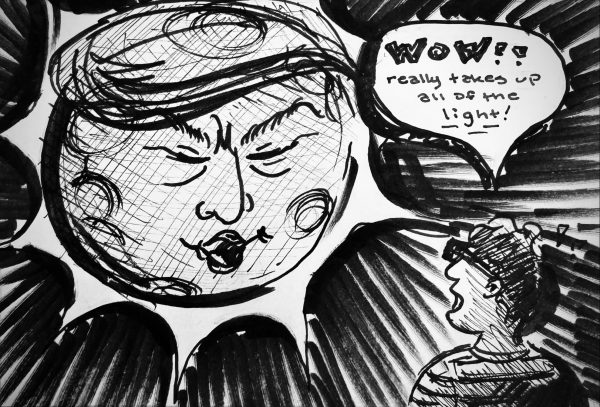Image of beauty is toxic in more ways than one
October 31, 2019
In 2018, a three-year-old toddler was hospitalized after playing with a dollar store toy makeup kit. This toxic makeup caused such a horrendous reaction that the intense blistering around her mouth left her unable to eat, and her eyes were so swollen she could barely open them.
The mortification lies in the realization that an innocent child mimicking her mother’s actions had to be hospitalized for trying to feel beautiful. I can imagine that the parents’ hearts must have stopped, and their palms clammed up as they looked down at their young toddler and saw the residue of a nightmarish chemical that burned their little girl’s face. It’s a feeling that leaves a pit in my stomach and a sour taste in my mouth. We are failing those who should be protected at all costs. What’s worse is that the toxicity in children’s makeup isn’t an isolated case.
There are other cases where children’s makeup tested positive for being toxic and potentially life-threatening. Earlier this year, jewelry and accessory store Claire’s issued a recall of three makeup products after they were tested positive for asbestos.
“We initiated this voluntary recall after testing by the U.S. Food and Drug Administration (FDA) indicated the possible presence of asbestos fibers in product samples from one lot of each product,” said Claire’s, in a statement posted on the FDA’s website. “Exposure to asbestos has been linked to several forms of cancer.”
The problem is that the FDA is lax in monitoring the chemicals in makeup. The FDA admits on its website that it doesn’t regulate makeup to the degree that it should. If that doesn’t scare you, it should. Under the law, cosmetic products and ingredients do not need FDA premarket approval, with the exception of color additives.
The FDA watches, but does not monitor regularly, unless any issues arise. “FDA can take action against unsafe cosmetics on the market, but we need to base that action on reliable information.”
The FDA scans the products for alteration in any form, if anything is decaying, contaminated by a filthy substance or reported by outbreak if the substance is poisonous. It also monitors for false advertising — for example, the trendy catchphrase, “all natural.” Even popular makeup brands that highlight being a natural product can contain toxic traces, such as Burt’s Bees, which has traces of lead in some of their products.
Mercury, a very dangerous, globally banned chemical, is allowed as a preservative in eye makeup.
Lead is in shampoo, lipstick, lip gloss and lotions in small traces, 10 parts per million which is the allowed amount.
These chemicals are incredibly toxic to our bodies, and we are poisoning ourselves slowly over time. Continued exposure of another chemical allowed by the FDA, chromium, can cause nasal and lung problems, and is actually labeled on cosmetic packages as a color additive so people can avoid an allergic reaction to it.
Furthermore, it’s tragic that being beautiful is so heavily attributed to makeup in our society.
Guess which top three brands have the highest lead reports? CoverGirl, L’Oréal and Revlon.
There is more information provided by safecosmetics.org. A page on this website, “Lead in Lipstick,” shames the FDA for stalling regulations for two years when outside research from testing was provided that proved there was lead in lipsticks. They revealed the top brands listed above and warned of other toxic heavy metals.
We willingly accept the risk for a second of feeling more beautiful rather than believing we already are.
In today’s society ‘you pick your poison,’ whether it’s in a monster energy drink that scars or induces heart attacks and brain aneurysms; in e-cigarettes that fry lungs, promoting cancer or burn holes in your trachea; alcohol; or radiation from electronic devices that cause cancer.
Yet, societies ingrained expectation of beauty is toxic in more ways than one.







